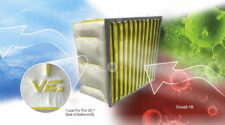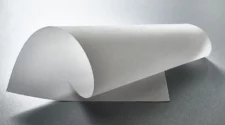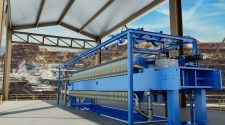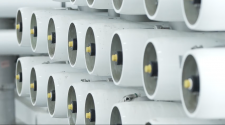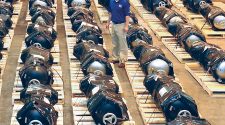We cannot keep dancing to the rhythm of wildfires, pandemics, and environmental disasters only to address the urgent air quality agenda. If we all aspire to having our cities be smart, our economies circular and our natural resources sustainable, we will need to embrace new business models and ways of living that take the planet, people and profit into account. That requires an agile strategy to address the “sustainability” pressing issues, whether air pollution and quality, thermal comfort, and energy efficiency or simply granting the planet a chance to regenerate itself. A healthy building envelope is essential to the well-being of human occupants, and therefore, air quality solutions should be established early on by design and not only by demand.
Sustainable urban development is not static and aims to achieve a prosperous society irrespective of living conditions and socioeconomic status. However, sustainable living cannot be achieved if we merely focus on surrounding ourselves with urban designs that aim to impress rather than enable agile strategies to protect our built environment. Relying solely on evoking the pleasures of spectacular landscapes is insufficient to render our built environment “safe to occupy.”
The Air We Breathe
The air we breathe is full of microscopic particles, which can be hazardous to health and are, thus, considered a specific type of air pollution (Figure 1). The size of these particles is in the order of several nanometers to several micrometers. Epidemiological studies have shown, beyond doubt, an association between increased urban air pollution and adverse health effects on susceptible sectors of the population, particularly the elderly who may have pre-existing respiratory or cardiovascular diseases [1,2]. Urban air contains particles whose size may be classified as coarse to ultrafine (<0.1 μm in diameter). Ultrafine particles contribute very little to the total mass in a sample of air. Still, they exist in very high numbers, which in episodic events can reach several hundred thousand/cm3 in urban air. Therefore, characterizing atmospheric pollutants is essential to understanding air filter performance and enhancing Indoor Air Quality (IAQ). Not all dust particles arise from human activity. High winds in desert regions and volcanic events are natural phenomena that cause high airborne dust concentrations. So, weather conditions, the natural environment, and human activities can cause windblown, construction, or fugitive dust, contributing to air pollution. High winds can raise large amounts of dust from dry, loose, or disturbed soil areas.
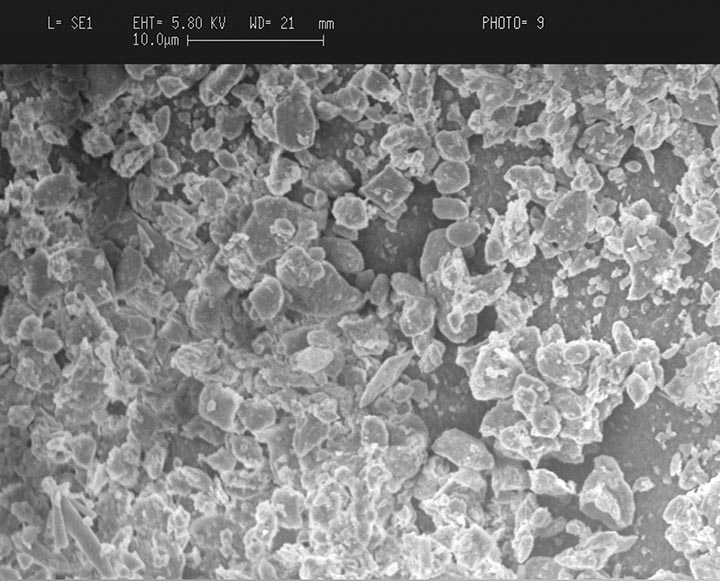
Wildfires and pandemics have remained the only nexus between achieving acceptable and best IAQ. The changing climate has modified weather patterns, influencing the levels and location of outdoor air pollutants such as wind-blown dust (Figure 2) and pollen (Figure 3). Eventually, any changes in outdoor air quality will impact the IAQ as pollutants and aeroallergens infiltrate building envelopes through cracks, windows, and doors, bypassing the air filters installed in HVAC systems. In contrast, the increasing demand for adhering to sustainable built environments emphasizes new policies, technologies, and innovation to avail the best IAQ. Although financial responsibilities remain at the forefront of our minds, a similar emphasis should be placed on our social obligations to protect the well-being of human occupants.
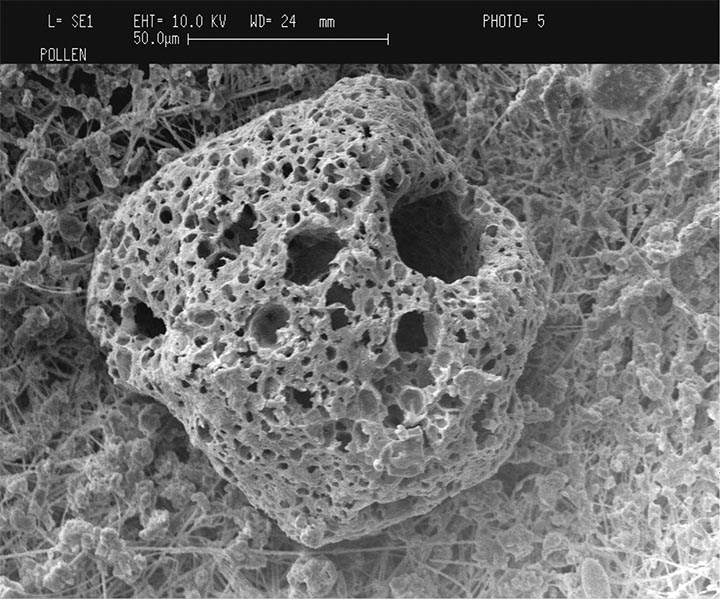
Striving Not Surviving
The importance of air quality cannot be dismissed. For air quality to improve, the built environment should strive for bold and comprehensive air quality policies and solutions to integrate them into adaptive HVAC systems to respond to any variations to IAQ. Furthermore, the appropriate employment of quantitative and qualitative methodologies relevant to designing, building, and operating the built environment and its envelope are also of paramount importance. Sustainable air quality solutions entail gas phase and particulate filtration encapsulated with data-driven HVAC systems able to respond quickly to variating IAQ that affects the well-being of human occupants. No one would tolerate thermal discomfort or a crowded room with poor ventilation and air quality.
Sustainable Air Filter Performance
The different perceptions of air quality enhancements affected how filters were and continue to be selected and acquired. We must face that we cannot rely on ordinary air filtration products while we demand extraordinary IAQ. However, sustainable air quality and filtration strategies cannot depend on moral forces and increasing awareness alone. A face mask can help us navigate the pandemic but cannot resolve the core air quality issues.
Air quality enhancement and filtration upgrades are frequently challenged and negotiated. Certainly, negotiation is welcomed if it is targeted to advance air quality measures and hold HVAC responsible for the well-being of human occupants. However, what is not negotiable is the value of better air quality brought about to the built environment, even if the public’s perception of air quality value may differ from one person to another.
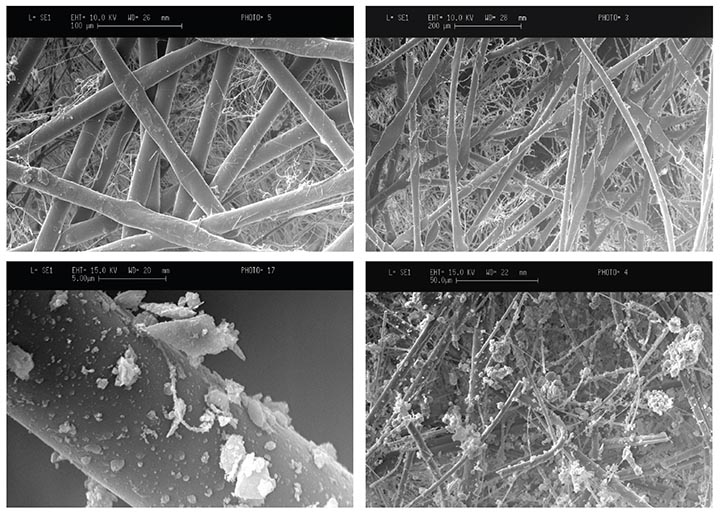
On the other hand, what should be promoted is the total cost of ownership once filter performance becomes the main criterion by which potential air quality value is achieved – independent of price. Furthermore, the total cost of ownership is the lifecycle-based assessment and forecast of all direct and indirect parameters and costs. Some of these considerations are appropriate filter design and media selection, HVAC operation and maintenance and air outdoor and IAQ monitoring which are key elements in the overall sustainable filter performance.
The scanned electron microscopic images shown in Figure 4 compare unloaded and loaded filter media with different scales.
Air Filter Selection
Research has revealed that the actual performance of the air filters installed in air-handling units tends to deviate from the performance predicted by laboratory test reports[3,4]. Various atmospheric airborne contaminants, moisture, and temperature can alter the air filter performance, and, therefore, their in-depth understanding of the physical and chemical characteristics and the climate conditions can prove invaluable for their appropriate selection and filter performance. Appropriate knowledge relevant to face velocity, particle concentration and size distribution, and temperature and humidity levels is essential to understanding filter performance. Other challenges confronting filter performance include upstream and downstream flow nonuniformity of filter pleats due to various media properties, cartridge design, and filter installation. In addition to filter loading characteristics and reliable velocity distribution, these parameters can influence the filter’s efficiency and sustainable performance. Therefore, appropriate filter selection should be delegated to filtration experts who can provide guidance and insights to enhance the air quality we eventually breathe.
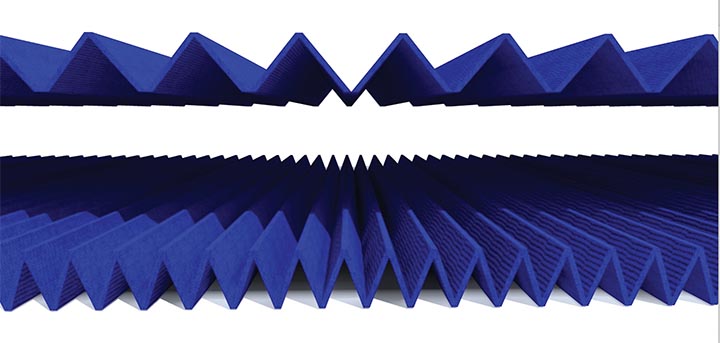
The designers of the built environment and its envelope need to reconsider several other parameters aside from filtration. Construction materials, facades, wall thickness, roofing, heat loads, lighting and noise also play a role in rendering the building fit to occupy. Optimizing the final outcomes, whether thermal comfort, building energy efficiency, air filter performance, HVAC equipment selection, and better IAQ are critical to the general comfort of human occupants. Considering that air quality is a byword for air filtration, the lifecycle-based assessment of filter performance parameters must be engineered to achieving better IAQ, which requires embarking on the following concrete steps:
- Conduct physical and chemical characterization of outdoor and indoor air to understand the pollutant types, concentration, and size distribution challenging installed air filters.
- Select appropriate air filters, media type, surface area (Figure 5), design, and the number of filtration stages required based on the findings above, the required flow rate, and the associated filter test reports.
- Ensure that air filters are operating in functional HVAC systems.
- Integrate air quality sensors for continuous monitoring and sustainable filter performance and assist the installed HVAC system in responding to any variation in IAQ.
- Identify the sources of indoor air pollution and tackle their emissions, including that due to human occupants.
- Conduct HVAC operation and maintenance measures accompanied by visual inspections.
Paying More Than Just Attention
The air quality issues faced today are manifest in our environmental behavior, how we choose to condition the air, and how we ventilate and filter the air. Enhancing filter efficiencies may require more than retrofitting and frequently replacing high-efficiency filters in the existing HVAC systems. After having characterized the outdoor air quality, defining the required filtration efficiency for a given building envelope is essential to selecting the number of filtration stages needed to attain air quality targets. Predictive HVAC maintenance programs and employing professional filtration plans can further foster healthy living environment for human occupants. However, the fluctuating momentum driven by pandemics and environmental disasters thwart any concrete plan for sustainable enhancements. Therefore, addressing the essentials of air quality and filtration technologies are paramount to raising the bar of sustainable living and to make our built environment contaminant and odor free.
It is our chance today to rethink, reenvision and reimagine how to attain air quality and employ several technologies, in addition to filtration, that can contribute to such an outcome. Chronic filter failures, and the addiction to washable filters have contributed to the deterioration of IAQ. Enhanced IAQ never gained the political traction needed to be a national priority, although the impact of escalating emissions has been well-pronounced. For decades, integrated air quality solutions have been frustrated by the complex structure and speed at which we now have to make decisions at all governmental levels – municipal, provincial, territorial, and federal.
Realignment
The paradox is that we desire enhanced IAQ, but more infrastructure is needed to support it. If infrastructure is defined as the fundamental facilities and systems accompanied by necessary services to serve a country, so should air quality. Air quality should continue to be a pillar of our vitality, global economy, and the foundation of sustainable and healthy built environments.
Collaboration among governments, consultants, industry leaders, and end users is essential to resolve what is ailing in outdoor and IAQ and realign current anthropogenic emissions and air quality endeavors toward sustainability. The central task lies in eliciting cooperative behavior and collaborative efforts to protect the general well-being of human occupants. Yet, the first realignment needs to be by design and not just by demand. When planning for sustainable built-environments and their building envelopes, it is critical to shift emphasis to what they can become and evolve into in the future if we are to embrace successful air quality strategies.
Let’s face it, environmentally speaking; we are running amuck when we consider the increased concentration of particulate matter and gaseous contaminants emitted annually. Allowing our outdoor air to deteriorate suggests that the consequences of poor air quality are acceptable for the built environment and the well-being of human occupants. The premise of continuing to pollute our air just because filtration technologies exist to capture them is unacceptable. Although air filtration technologies are the low-hanging fruit that designers can capitalize on in their endeavor to provide clean air, the question remains whether or not the available filter technologies can capture all of the inevitable emissions without addressing emission reduction.
The Sands of Hope
While the historic call for adhering to financial responsibilities always hovers in our minds, our social responsibility to avail the best IAQ is equally important. Enhancing indoor IAQ requires policies, relevant standards, and roadmaps to ensure implementation and compliance are entwined, not just the moral forces of the general public.
Dreaming of the best air quality will only bring us to our goals if progress translates our reality to a promising future of healthily built environments. Furthermore, aspiring to the highest standards of built environments requires architects of the unseen, experts of the unknown, and consultants of the unpredictable. If sustainable healthy living is to be embraced, we must define air quality before we defend it. Ultimately, if air quality and filtration strategies are drafted on the sands of hope, left without actions, they will soon see the sea.


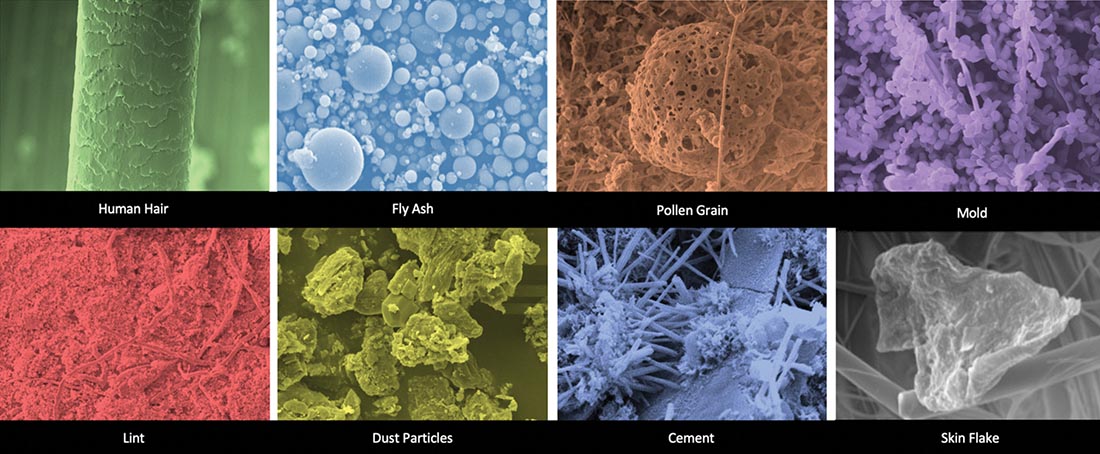
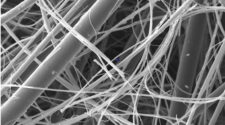
![Figure 1: Heat Exchanger Proventics GMBH.[22]](https://www.filtnews.com/wp-content/uploads/IFN_2_2024_crimpedmicrofiberyarns_Fig.-1-Heat-exchanger-225x125.jpg)

